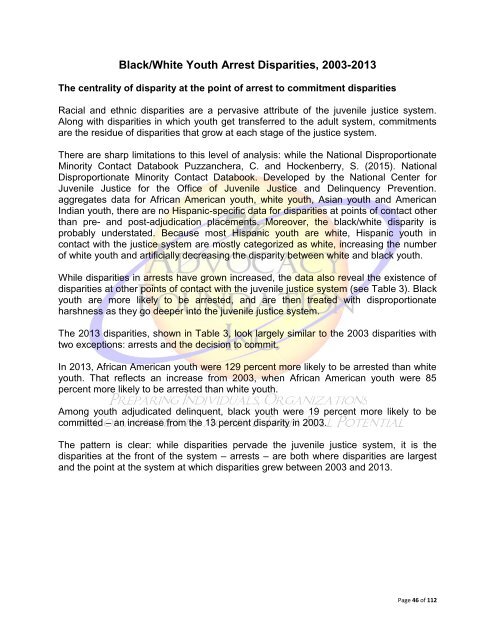Latino and Hispanic Youth in the Juvenile Justice System
Latino and Hispanic Youth in the Juvenile Justice System
Latino and Hispanic Youth in the Juvenile Justice System
Create successful ePaper yourself
Turn your PDF publications into a flip-book with our unique Google optimized e-Paper software.
Black/White <strong>Youth</strong> Arrest Disparities, 2003-2013<br />
The centrality of disparity at <strong>the</strong> po<strong>in</strong>t of arrest to commitment disparities<br />
Racial <strong>and</strong> ethnic disparities are a pervasive attribute of <strong>the</strong> juvenile justice system.<br />
Along with disparities <strong>in</strong> which youth get transferred to <strong>the</strong> adult system, commitments<br />
are <strong>the</strong> residue of disparities that grow at each stage of <strong>the</strong> justice system.<br />
There are sharp limitations to this level of analysis: while <strong>the</strong> National Disproportionate<br />
M<strong>in</strong>ority Contact Databook Puzzanchera, C. <strong>and</strong> Hockenberry, S. (2015). National<br />
Disproportionate M<strong>in</strong>ority Contact Databook. Developed by <strong>the</strong> National Center for<br />
<strong>Juvenile</strong> <strong>Justice</strong> for <strong>the</strong> Office of <strong>Juvenile</strong> <strong>Justice</strong> <strong>and</strong> Del<strong>in</strong>quency Prevention.<br />
aggregates data for African American youth, white youth, Asian youth <strong>and</strong> American<br />
Indian youth, <strong>the</strong>re are no <strong>Hispanic</strong>-specific data for disparities at po<strong>in</strong>ts of contact o<strong>the</strong>r<br />
than pre- <strong>and</strong> post-adjudication placements. Moreover, <strong>the</strong> black/white disparity is<br />
probably understated. Because most <strong>Hispanic</strong> youth are white, <strong>Hispanic</strong> youth <strong>in</strong><br />
contact with <strong>the</strong> justice system are mostly categorized as white, <strong>in</strong>creas<strong>in</strong>g <strong>the</strong> number<br />
of white youth <strong>and</strong> artificially decreas<strong>in</strong>g <strong>the</strong> disparity between white <strong>and</strong> black youth.<br />
While disparities <strong>in</strong> arrests have grown <strong>in</strong>creased, <strong>the</strong> data also reveal <strong>the</strong> existence of<br />
disparities at o<strong>the</strong>r po<strong>in</strong>ts of contact with <strong>the</strong> juvenile justice system (see Table 3). Black<br />
youth are more likely to be arrested, <strong>and</strong> are <strong>the</strong>n treated with disproportionate<br />
harshness as <strong>the</strong>y go deeper <strong>in</strong>to <strong>the</strong> juvenile justice system.<br />
The 2013 disparities, shown <strong>in</strong> Table 3, look largely similar to <strong>the</strong> 2003 disparities with<br />
two exceptions: arrests <strong>and</strong> <strong>the</strong> decision to commit.<br />
In 2013, African American youth were 129 percent more likely to be arrested than white<br />
youth. That reflects an <strong>in</strong>crease from 2003, when African American youth were 85<br />
percent more likely to be arrested than white youth.<br />
Among youth adjudicated del<strong>in</strong>quent, black youth were 19 percent more likely to be<br />
committed – an <strong>in</strong>crease from <strong>the</strong> 13 percent disparity <strong>in</strong> 2003.<br />
The pattern is clear: while disparities pervade <strong>the</strong> juvenile justice system, it is <strong>the</strong><br />
disparities at <strong>the</strong> front of <strong>the</strong> system – arrests – are both where disparities are largest<br />
<strong>and</strong> <strong>the</strong> po<strong>in</strong>t at <strong>the</strong> system at which disparities grew between 2003 <strong>and</strong> 2013.<br />
Page 46 of 112

















